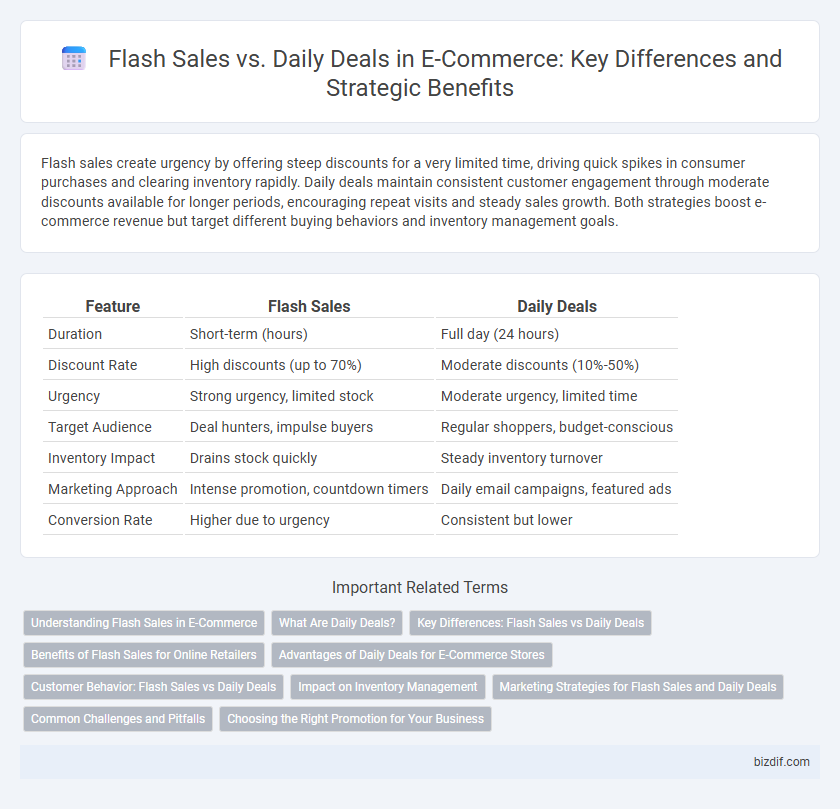Flash sales create urgency by offering steep discounts for a very limited time, driving quick spikes in consumer purchases and clearing inventory rapidly. Daily deals maintain consistent customer engagement through moderate discounts available for longer periods, encouraging repeat visits and steady sales growth. Both strategies boost e-commerce revenue but target different buying behaviors and inventory management goals.
Table of Comparison
| Feature | Flash Sales | Daily Deals |
|---|---|---|
| Duration | Short-term (hours) | Full day (24 hours) |
| Discount Rate | High discounts (up to 70%) | Moderate discounts (10%-50%) |
| Urgency | Strong urgency, limited stock | Moderate urgency, limited time |
| Target Audience | Deal hunters, impulse buyers | Regular shoppers, budget-conscious |
| Inventory Impact | Drains stock quickly | Steady inventory turnover |
| Marketing Approach | Intense promotion, countdown timers | Daily email campaigns, featured ads |
| Conversion Rate | Higher due to urgency | Consistent but lower |
Understanding Flash Sales in E-Commerce
Flash sales in e-commerce are limited-time promotions offering substantial discounts on select products to create urgency and boost rapid sales. These sales often last a few hours or a day, leveraging scarcity and impulse buying to increase conversion rates and clear inventory quickly. Compared to daily deals, flash sales emphasize immediate action, driving higher traffic spikes and fostering customer engagement through time-sensitive offers.
What Are Daily Deals?
Daily deals are limited-time promotions offering significant discounts on specific products or services, typically available for 24 hours. These deals aim to attract frequent shoppers by providing consistent value and encouraging repeat visits to e-commerce platforms. Retailers use daily deals to boost sales volume and clear inventory while maintaining customer engagement.
Key Differences: Flash Sales vs Daily Deals
Flash sales offer limited-time, deep discounts on select products, creating urgency and driving immediate purchases, whereas daily deals provide moderate discounts on a rotating selection of items available for a full day, encouraging consistent customer engagement. Flash sales often require rapid inventory turnover and are ideal for clearing stock quickly, while daily deals focus on steady traffic and long-term customer retention. The distinct timing and discount strategies of flash sales versus daily deals directly impact conversion rates and promotional planning in e-commerce.
Benefits of Flash Sales for Online Retailers
Flash sales create a sense of urgency that drives rapid customer purchases, increasing conversion rates and clearing inventory swiftly. These time-limited promotions boost website traffic significantly, enhancing brand visibility and attracting new buyers. Flash sales also enable online retailers to test product demand efficiently while maximizing short-term revenue.
Advantages of Daily Deals for E-Commerce Stores
Daily deals boost customer engagement by offering limited-time discounts that encourage repeat visits and foster brand loyalty. These deals create a sense of urgency without overwhelming customers, helping to maintain steady sales and improve inventory turnover. E-commerce stores benefit from increased average order values as shoppers frequently add complementary items to maximize deal savings.
Customer Behavior: Flash Sales vs Daily Deals
Flash sales create urgency by offering limited-time discounts that encourage impulsive purchases, resulting in higher conversion rates during short periods. Daily deals, featuring consistent but less aggressive discounts, attract bargain hunters who prefer planned shopping and repeated visits. Understanding these behaviors helps e-commerce platforms tailor marketing strategies to maximize engagement and revenue.
Impact on Inventory Management
Flash sales create sudden spikes in demand, requiring agile inventory management systems to prevent stockouts and optimize replenishment cycles. Daily deals offer a steadier, more predictable sales pattern, allowing for better forecasting and consistent inventory turnover. Effective integration of sales strategies with inventory analytics reduces holding costs and improves fulfillment accuracy.
Marketing Strategies for Flash Sales and Daily Deals
Flash sales leverage urgency and scarcity by offering limited-time deep discounts, driving rapid customer engagement and boosting short-term revenue. Daily deals focus on consistent value propositions with curated offers that encourage repeat visits and sustained customer loyalty. Combining targeted email campaigns, social media advertising, and real-time analytics maximizes conversion rates for both flash sales and daily deals in e-commerce marketing strategies.
Common Challenges and Pitfalls
Flash sales and daily deals often face inventory management issues, leading to stockouts or overstock situations that impact customer satisfaction and revenue. Both strategies can cause brand dilution when discounts become expected, reducing perceived value and long-term profitability. Limited-time offers may also result in rushed marketing efforts, causing ineffective targeting and missed sales opportunities.
Choosing the Right Promotion for Your Business
Flash sales create urgency with limited-time offers, driving quick spikes in sales and clearing inventory fast, making them ideal for businesses seeking rapid customer engagement. Daily deals provide consistent discounts that attract repeat buyers and build long-term customer loyalty, suitable for brands emphasizing steady revenue growth. Assessing your target audience's purchasing behavior and inventory goals helps determine whether flash sales' immediacy or daily deals' predictability better align with your business strategy.
Flash Sales vs Daily Deals Infographic

 bizdif.com
bizdif.com